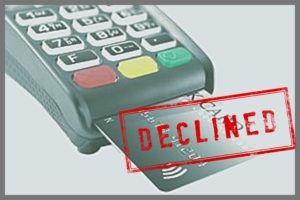“What’s a convenience fee?” … “Who can charge one?” … “How does it differ from a surcharge? … “What if I’m a government agency, a school, college or university? What’s allowed?” …
Understanding the two types of fees — what they are, what’s permitted, and who can charge them — is enough to make anyone’s head spin.
That said, this article is written to shed some light on the subject and hopefully provide clarity around what can be a very confusing topic. As always, if you have any questions, feel free to send us an email or call 888.248.7060.
What’s a Convenience Fee? Who Can Charge a Convenience Fee?
A convenience fee is a fee charged for the “convenience” of being able to pay using an alternative payment channel outside the merchant’s customary payment channel.
Any merchant can charge a convenience fee IF the fee charged is for the legitimate convenience of being able to pay using a different payment channel than the merchant’s usual payment channel.
Here’s an example to illustrate: A movie theater’s customary payment channel is face-to-face. If the theater provides an alternative payment channel, such as the option to pay by phone using a credit card, that theater could then charge a convenience fee along with the ticket payment.
That being said, Mail Order/Telephone Order (MOTO) merchants and ecommerce merchants, whose customary payment channel is exclusively non face-to-face, are NOT permitted to charge convenience fees.
A Look at Convenience Fee Rules
The general rules for convenience fees are as follows:
1. The customer must be notified of the convenience fee prior to finalizing payment and given the opportunity to cancel.
2. The payment must take place through an alternative payment channel.
3. The fee can only be added to a non face-to-face transaction.
4. The fee must be flat or fixed, regardless of the value of the payment due.
5. The fee must be applied to all means of payment accepted through the alternative payment channel.
6. The fee must be included in the total transaction amount.

The Exception to the Rule!
It’s Different for Government and Education Institutions
Yep. Just like many things in life, there is an exception to the rule … that is: government agencies, schools, colleges and universities can apply convenience fees in both card present and card not present environments.
Why is it different if you’re a government or educational entity?
Think of tax payments. The IRS is required by law to collect the full amount of any tax owed. Not imposing a convenience fee would mean that the IRS would receive tax payment less the credit card processing fee.
In other words, as said by Ted Carr, a spokesperson for VISA, “Income taxes are government mandates, and federal statute prohibits the Internal Revenue Service from paying the costs associated with credit card acceptance.”
Since many of our channel partners provide software to government and education merchants, it’s worth noting here the merchant category codes (MCCs) where convenience fees can be applied:
MCC 9311 — Tax Payments
MCC 9222 — Fines
MCC 9211 — Court Costs including Alimony and Child Support
MCC 9399 — Government Services – Not Elsewhere Classified
MCC 8220 — Colleges, Universities, Professional Schools and Junior Colleges
MCC 8244 — Schools, Business and Secretarial
MCC 8249 — Schools, Trade and Vocational
MCC 8211 — Schools, Elementary and Secondary
Implementing New Functionality and Logic Within Your Software
In a recent platform update, we expanded our functionality to enable our channel partners to deploy convenience fee logic within their software.
With the new enhancements, software end users can charge a fixed dollar amount and/or fixed percentage across five different tiers.
The expanded functionality also includes a dynamic convenience fee option that can be added as an extra service. This enhancement automatically adds a flexible rate based on the actual cost of the transaction by card type.
The dynamic convenience fee option ultimately enables the customer making the payment to pay a lower convenience fee at the time of check-out. Customers can choose to pay with a card that has a lower interchange rate associated with it, as opposed to paying a greater convenience fee by using a card with a higher interchange rate associated with it, such as a rewards card.
How Does a Surcharge Differ from a Convenience Fee? Who Can Charge a Surcharge?
A surcharge is a fee added to the cost of a purchase for the “privilege” of using a credit card. A surcharge is a percentage of the value of the sale. Surcharges are typically used to cover the cost of the merchant service charge.
It’s extremely important to weigh the pros and cons before surcharging as there are many rules, exceptions and state laws to observe to ensure you are compliant.
Presently, there are surcharge bans in the following states: Connecticut, Maine, Massachusetts, New York, and Puerto Rico.
These states have increased restrictions: California, Georgia, Indiana, Iowa, Michigan, Ohio, Oklahoma, Pennsylvania, and Texas
Again, there are lots of rules around surcharging, so if you’re in one of these states, or have any questions on surcharging, reach out to us.
A Look at Surcharge Rules
The general rules for surcharges are as follows:
1. Surcharges can be applied only to credit card transactions, not debit or prepaid card transactions.
2. The surcharge cannot be greater than the merchant’s average discount rate for that brand’s credit card transactions.
3. 4% is the maximum surcharge allowed.
4. The cardholder must be notified of the surcharge.
5. The surcharge must be listed on the receipt as a line item.
6. The surcharge and the primary payment amount must be processed together as one transaction.
Let Us Help …
As you’ve now learned, there are many rules around convenience fees and surcharges. That’s why we strongly advise that you conduct a thorough review of your business or institution prior to deciding whether or not you should implement these fees.
We’re happy to work with you and figure out what’s right for your software business and your customers. Give us a call at 888.248.7060 or send an email.




